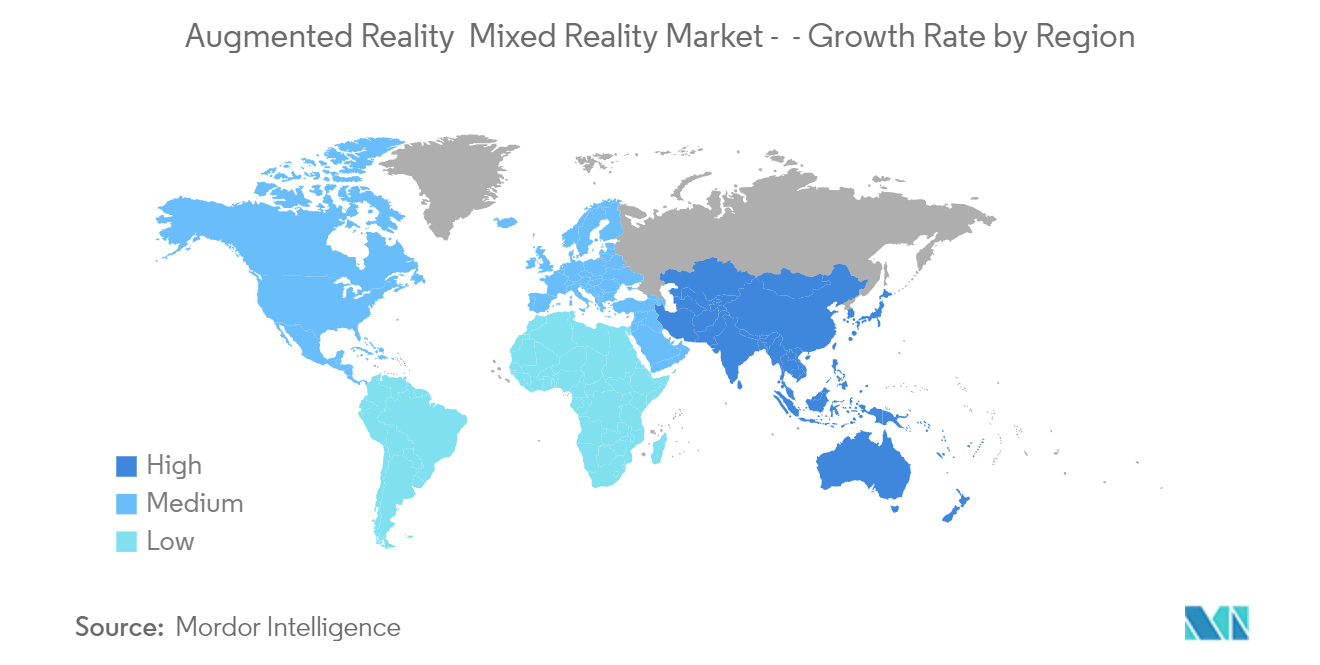Market Trends of Augmented Reality & Mixed Reality Industry
This section covers the major market trends shaping the Augmented Reality & Mixed Reality Market according to our research experts:
Increasing Applications of Augmented Reality Drives the Market Growth
- In the current market scenario, virtual reality is leading mass market adoption, predominantly due to the large-scale availability of low-cost VR devices. However, lowering the cost of solutions and advancements in image recognition and location services have augmented the potential of the AR market.
- The precision of indoor location services has grown significantly, enabling AR location features for vehicle, campus, and in-building navigation and identification. Image recognition capabilities have allowed enterprises to use AR for object identification and display by assisting real-time decision-making. For instance, firefighters can use AR to find the ambient temperature or a building layout to know exits and potentially dangerous areas. These technologies together provide various benefits of using AR as an internal tool. This includes enhancing current business processes, facilitating and optimizing current technologies, and giving business innovation.
- In addition, improving shopping experiences by integrating AR with technologies (such as beacons and RFID) is expected to help brands personalize and distinguish their services, bridging the gap between customer expectations and business products and services. According to a survey conducted by Snap Inc., There were various reasons why people all around the globe would be interested in adopting augmented reality for online shopping. A third of those surveyed said they would use AR to experience a full 360-degree view of a product, while another third said they would use it to see how products would appear on them. One in every five buyers mentioned they were interested because technology may make their shopping experience more enjoyable.
- Various cosmetic companies and brands are also implementing AR into business. For instance, Sephora uses AR technology to allow customers to try out different looks, eyes, lips, cheek products, and colors on their digital faces. This is an opportunity to boost sales and give customers a fun way to try out new looks. In the same way, to inspire purchases, Rolex also makes use of AR. The company has developed a virtual try-on experience where prospective customers can try different styles and models.
- There are some fascinating applications for augmented reality in healthcare, from allowing medical students to train in AR environments to telemedicine options that enable medical professionals to interact with patients. For instance, AccuVein, a handheld device, can scan the vein network of a patient and lead to a 45% reduction in escalations with the help of AR diagnostic tools.
- The future of the AR market is expected to be augmented by the amalgamation of the virtual and physical worlds to generate new, engaging, interactive, and personalized experiences that benefit both customers and the business.

Asia Pacific is Expected to be the Fastest Growing Market
- There has been increasing adoption of AR for different applications in Asia-Pacific, such as the automotive, healthcare, manufacturing, entertainment, infrastructure, and public and private sectors. This is one of the significant factors contributing to the growth of the AR market in the region. Also, the growing investments by the government and private institutions for developing startups based on AR are expected to drive the market's growth in the forecast period.
- China is one of the largest smartphone markets, followed by India. With the increasing penetration of mobile AR applications, smartphones play a significant role in developing the AR market in the form of mobile AR. Increasing smartphone demand in China and India, followed by Japan, South Korea, and Australia, is expected to provide further growth opportunities to the market in the region.
- In healthcare, AR helps interact with information via voice commands, gestures, and motion tracking. Companies have also been increasing the penetration of connected devices and investments to make various kinds of devices equipped with AR, such as handheld, head-mounted displays, etc., further boosting AR in the healthcare market.
- Various companies have been looking forward to building an Augmented reality ecosystem for businesses in Indonesia. For instance, Indosat Ooredoo is working with Snap to accelerate the adoption of Augmented Reality, aiming to drive innovation within the field of AR to bring communities and businesses closer despite the pandemic. As part of the partnership, Indosat Ooredoo and Snap would launch multiple AR-specific programs to empower and engage Indonesians and develop business opportunities in Indonesia.


